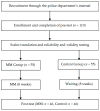Effects of Short Video App Guided Mindfulness Meditation on Policemen's Communication Anxiety, PTSD, Anger Management, and Mood Disorders
- PMID: 40428049
- PMCID: PMC12110842
- DOI: 10.3390/healthcare13101213
Effects of Short Video App Guided Mindfulness Meditation on Policemen's Communication Anxiety, PTSD, Anger Management, and Mood Disorders
Abstract
Background: Law enforcement is a high-stress profession, with officers frequently exposed to traumatic events, leading to mental health challenges such as communication anxiety, post-traumatic stress disorder (PTSD), anger management difficulties, and mood disorders. Mindfulness meditation (MM), particularly when guided through short video applications, has shown promise in addressing these issues by enhancing emotional regulation and resilience.
Objective: This study explores the effects of an 8-week MM intervention, delivered via short video apps, on communication anxiety, PTSD, anger management, and mood disorders in police officers.
Methods: A randomized controlled trial (RCT) was conducted with 110 full-time police officers aged 25-55 in China. The final 92 eligible participants were divided into two groups: the MM group (n = 46) and the control group (n = 46). The intervention consisted of daily 10-15 min video-guided MM sessions. Pre- and post-intervention measures included validated questionnaires assessing communication anxiety (PRCA-24), PTSD (PCL-5), anger management (STAXI-2), and mood disorders (DASS-21). Data analysis was performed using MANOVA.
Results: The intervention group showed significant improvements in communication anxiety (F = 8.505, p = 0.004), PTSD (F = 25.831, p < 0.001), anger management (F = 4.968, p = 0.027), and mood disorders (F = 13.058, p < 0.001) compared to the control group. These improvements were supported by significant interaction effects between group and time, indicating that the MM intervention had a positive impact on these mental health variables.
Conclusions: Video-guided MM delivered via short video apps significantly reduced communication anxiety, PTSD symptoms, and mood disorders, and improved anger management among police officers. These findings highlight the potential of digital MM interventions as a scalable and accessible tool for enhancing mental well-being and resilience in law enforcement personnel.
Keywords: PTSD; anger; communication anxiety; mindfulness meditation; police officers.
Conflict of interest statement
The authors declare that the research was conducted in the absence of any commercial or financial relationships that could be construed as a potential conflict of interest.
Figures



Similar articles
-
The Effects of Loving-Kindness Meditation Guided by Short Video Apps on Policemen's Mindfulness, Public Service Motivation, Conflict Resolution Skills, and Communication Skills.Behav Sci (Basel). 2025 Jul 4;15(7):909. doi: 10.3390/bs15070909. Behav Sci (Basel). 2025. PMID: 40723692 Free PMC article.
-
Web-Based Mindfulness Meditation as an Adjunct to Internet-Delivered Cognitive Behavioral Therapy for Public Safety Personnel: Mixed Methods Feasibility Evaluation Study.JMIR Form Res. 2024 Jan 30;8:e54132. doi: 10.2196/54132. JMIR Form Res. 2024. PMID: 38289655 Free PMC article.
-
Higher frequency of mantram repetition practice is associated with enhanced clinical benefits among United States Veterans with posttraumatic stress disorder.Eur J Psychotraumatol. 2022 Jun 10;13(1):2078564. doi: 10.1080/20008198.2022.2078564. eCollection 2022. Eur J Psychotraumatol. 2022. PMID: 35713599 Free PMC article.
-
Mobile apps to reduce depressive symptoms and alcohol use in youth: A systematic review and meta-analysis: A systematic review.Campbell Syst Rev. 2024 Apr 26;20(2):e1398. doi: 10.1002/cl2.1398. eCollection 2024 Jun. Campbell Syst Rev. 2024. PMID: 38680950 Free PMC article. Review.
-
A systematic review of the current evidence regarding interventions for anxiety, PTSD, sleepiness and fatigue in the law enforcement workplace.Ind Health. 2019 Nov 29;57(6):655-667. doi: 10.2486/indhealth.2018-0088. Epub 2019 Feb 13. Ind Health. 2019. PMID: 30760652 Free PMC article.
Cited by
-
Effect of digital mindfulness on perceived stress and anxious emotion among college students.Front Psychiatry. 2025 Aug 1;16:1644370. doi: 10.3389/fpsyt.2025.1644370. eCollection 2025. Front Psychiatry. 2025. PMID: 40821014 Free PMC article.
References
-
- Bullock K., Garland J. Policing and Mental Health. Routledge; London, UK: 2020. Understanding the mental health and well-being of police officers: Causes, consequences and responses to stressors in police work; pp. 241–253.
-
- Ménard K.S., Arter M.L. Stress, coping, alcohol use, and posttraumatic stress disorder among an international sample of police officers: Does gender matter? Police Q. 2014;17:307–327. doi: 10.1177/1098611114548097. - DOI
-
- Vitale A., Byma L., Sun S., Podolak E., Wang Z., Alter S., Galfalvy H., Geraci J., Langhoff E., Klingbeil H. Effectiveness of complementary and integrative approaches in promoting engagement and overall wellness toward suicide prevention in veterans. J. Altern. Complement. Med. 2021;27:S14–S27. doi: 10.1089/acm.2020.0245. - DOI - PMC - PubMed
-
- Ballenger J.F., Best S.R., Metzler T.J., Wasserman D.A., Mohr D.C., Liberman A., Delucchi K., Weiss D.S., Fagan J.A., Waldrop A.E., et al. Patterns and predictors of alcohol use in male and female urban police officers. Am. J. Addict. 2011;20:21–29. doi: 10.1111/j.1521-0391.2010.00092.x. - DOI - PMC - PubMed
LinkOut - more resources
Full Text Sources

